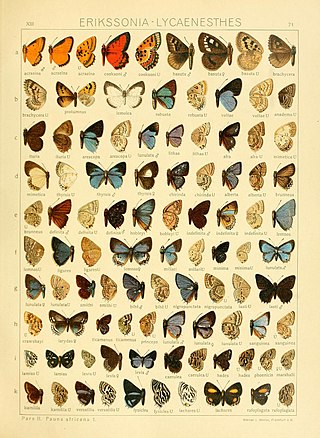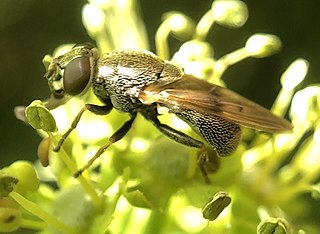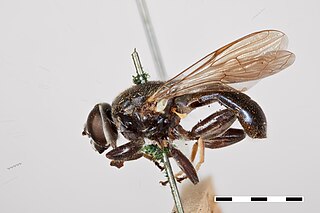
Blue-ringed octopuses, comprising the genus Hapalochlaena, are four extremely venomous species of octopus that are found in tide pools and coral reefs in the Pacific and Indian oceans, from Japan to Australia. They can be identified by their yellowish skin and characteristic blue and black rings that can change color dramatically when the animal is threatened. They eat small crustaceans, including crabs, hermit crabs, shrimp, and other small sea animals.

The blue-lined octopus is one of four species of highly venomous blue-ringed octopuses. It can be found in Pacific Ocean waters that stretch from Australia to Japan. It is most commonly found around intertidal rocky shores and coastal waters to a depth of 15 metres (49 ft) between southern Queensland and southern New South Wales. It is relatively small, with a mantle up to 45 millimetres (1.8 in) in length. In its relaxed state, it is a mottled yellow-brown with dark blue or black streaks covering the whole body apart from the underside of its arms, but its vibrant blue markings appear as a warning to predators when it feels threatened. Along with its other closely related species, the blue-lined octopus is regarded as one of the most dangerous animals in the sea, and its venom can be fatal to humans. This benthic octopus is one of four members of the genus Hapalochlaena, with the other species being the greater blue-ringed octopus, southern blue-ringed octopus, and the blue-ringed octopus. The blue-lined octopus is the only species of the four to display lined iridescent blue marking, as opposed to circular iridescent blue marking that the three other species tend to exhibit.
Myolepta potens is a European hoverfly.

The painted spurfowl is a bird of the pheasant family found in rocky hill and scrub forests mainly in peninsular India. Males are more brightly coloured and spotted boldly in white. Males have two to four spurs while females can have one or two of the spurs on their tarsus. The species is found mainly in rocky and scrub forest habitats unlike the red spurfowl. It is found in the undergrowth in pairs or small groups, escaping by running and rarely taking to the wing when flushed.

The Bassian thrush, also known as the olive-tailed thrush, is a medium-sized mostly insectivorous thrush found from northern Queensland to southeastern Australia; it also occurs in Tasmania, on some larger islands of Bass Strait, and on Kangaroo Island. The thrushes range from 27 to 29 cm in length and average 100 g (3.5 oz).

The western wattlebird is a passerine bird in the honeyeater family, Meliphagidae. It is restricted to south-western Australia.

Ophrys lunulata, the moon orchid, is a species of orchid native to the islands of Malta and Sicily in the central Mediterranean.

Myolepta is a cosmopolitan genus of hoverflies most closely related to the genus Lepidomyia

The Brachyopini is a tribe of hoverflies. Unlike many members of this family these flies are generally darker and less colourful though some genera contain species with an attractive metallic lustre e.g. Chrysogaster. Some like Brachyopa are associated with sap runs where their larvae feed on decaying sap. Others are found in boggy areas where their often semiaquatic larvae feed on decaying organic matter.

Antinephele lunulata is a moth of the family Sphingidae. It was described by Rothschild and Jordan in 1903, and is known from forests and wooded habitats from Sierra Leone to Cameroon, the Democratic Republic of the Congo, Zambia, Zimbabwe and Tanzania, as well as Madagascar.

Calliteara lunulata is a moth of the family Erebidae. It is found in the Russian Far East, Japan, China and Taiwan.
Endotricha lunulata is a species of snout moth in the genus Endotricha. It was described by Wang and Li, in 2005, and is known from China.

Anthene lunulata, the lunulated hairtail and red-spot ciliate blue, is a butterfly in the family Lycaenidae. It is found in Senegal, Gambia, Mali, Burkina Faso, Guinea, Sierra Leone, Liberia, Ivory Coast, Ghana, Togo, Benin, Nigeria, Cameroon, Sudan, the Democratic Republic of the Congo, Angola, Zambia, Kenya, Zimbabwe, Mozambique and north-eastern Botswana. The habitat consists of savanna and forests.

The Luna lionfish, the dragon's beard fish or Japanese lionfish, is a species of marine ray-finned fish belonging to the family Scorpaenidae, which consists of scorpionfishes and lionfishes. It is found in the western Pacific Ocean.

Myolepta strigilata, the Scaled Pegleg, is an uncommon species of syrphid fly observed in the eastern and central United States. Hoverflies can remain nearly motionless in flight. The adults are also known as flower flies for they are commonly found on flowers, from which they get both energy-giving nectar and protein-rich pollen. The larvae of this genus have been found in rot holes of deciduous trees.

Myolepta nigra , the Black Pegleg , is an uncommon species of syrphid fly observed in the eastern and central United States and Eastern Canada. Hoverflies can remain nearly motionless in flight. The adults are also known as flower flies for they are commonly found on flowers from which they get both energy-giving nectar and protein-rich pollen. The larvae of this genus are found in the rotholes of deciduous trees.

Myolepta varipes , the Orange-banded Pegleg , is an uncommon species of syrphid fly observed in the eastern half of the United States. Hoverflies can remain nearly motionless in flight. The adults are also known as flower flies, for they are commonly found on flowers from which they get both energy-giving nectar and protein-rich pollen. The larvae of this genus are found in the rot holes of deciduous trees.
Cyclocephala lunulata is a species of beetle in the family Scarabaeidae.

Antheminia is a genus of true bugs belonging to the family Pentatomidae.















